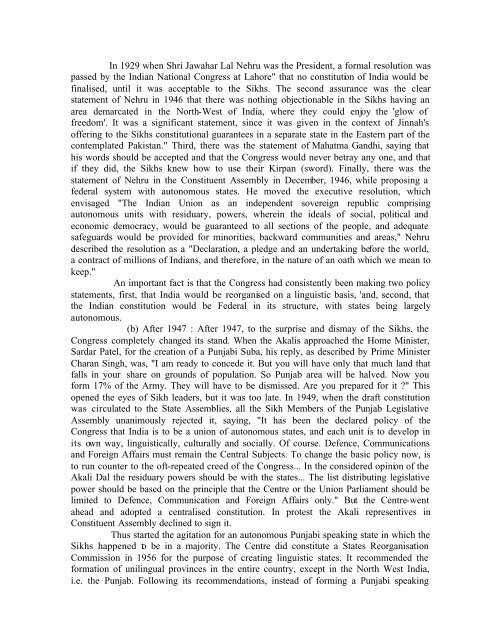Fundamentalism and the Sikh Religious Tradition by T.N. Madan
Fundamentalism and the Sikh Religious Tradition by T.N. Madan
Fundamentalism and the Sikh Religious Tradition by T.N. Madan
Create successful ePaper yourself
Turn your PDF publications into a flip-book with our unique Google optimized e-Paper software.
In 1929 when Shri Jawahar Lal Nehru was <strong>the</strong> President, a formal resolution was<br />
passed <strong>by</strong> <strong>the</strong> Indian National Congress at Lahore" that no constitution of India would be<br />
finalised, until it was acceptable to <strong>the</strong> <strong>Sikh</strong>s. The second assurance was <strong>the</strong> clear<br />
statement of Nehru in 1946 that <strong>the</strong>re was nothing objectionable in <strong>the</strong> <strong>Sikh</strong>s having an<br />
area demarcated in <strong>the</strong> North-West of India, where <strong>the</strong>y could enjoy <strong>the</strong> 'glow of<br />
freedom'. It was a significant statement, since it was given in <strong>the</strong> context of Jinnah's<br />
offering to <strong>the</strong> <strong>Sikh</strong>s constitutional guarantees in a separate state in <strong>the</strong> Eastern part of <strong>the</strong><br />
contemplated Pakistan." Third, <strong>the</strong>re was <strong>the</strong> statement of Mahatma G<strong>and</strong>hi, saying that<br />
his words should be accepted <strong>and</strong> that <strong>the</strong> Congress would never betray any one, <strong>and</strong> that<br />
if <strong>the</strong>y did, <strong>the</strong> <strong>Sikh</strong>s knew how to use <strong>the</strong>ir Kirpan (sword). Finally, <strong>the</strong>re was <strong>the</strong><br />
statement of Nehru in <strong>the</strong> Constituent Assembly in December, 1946, while proposing a<br />
federal system with autonomous states. He moved <strong>the</strong> executive resolution, which<br />
envisaged "The Indian Union as an independent sovereign republic comprising<br />
autonomous units with residuary, powers, wherein <strong>the</strong> ideals of social, political <strong>and</strong><br />
economic democracy, would be guaranteed to all sections of <strong>the</strong> people, <strong>and</strong> adequate<br />
safeguards would be provided for minorities, backward communities <strong>and</strong> areas," Nehru<br />
described <strong>the</strong> resolution as a "Declaration, a pledge <strong>and</strong> an undertaking before <strong>the</strong> world,<br />
a contract of millions of Indians, <strong>and</strong> <strong>the</strong>refore, in <strong>the</strong> nature of an oath which we mean to<br />
keep."<br />
An important fact is that <strong>the</strong> Congress had consistently been making two policy<br />
statements, first, that India would be reorganised on a linguistic basis, '<strong>and</strong>, second, that<br />
<strong>the</strong> Indian constitution would be Federal in its structure, with states being largely<br />
autonomous.<br />
(b) After 1947 : After 1947, to <strong>the</strong> surprise <strong>and</strong> dismay of <strong>the</strong> <strong>Sikh</strong>s, <strong>the</strong><br />
Congress completely changed its st<strong>and</strong>. When <strong>the</strong> Akalis approached <strong>the</strong> Home Minister,<br />
Sardar Patel, for <strong>the</strong> creation of a Punjabi Suba, his reply, as described <strong>by</strong> Prime Minister<br />
Charan Singh, was, "I am ready to concede it. But you will have only that much l<strong>and</strong> that<br />
falls in your share on grounds of population. So Punjab area will be halved. Now you<br />
form 17% of <strong>the</strong> Army. They will have to be dismissed. Are you prepared for it ?" This<br />
opened <strong>the</strong> eyes of <strong>Sikh</strong> leaders, but it was too late. In 1949, when <strong>the</strong> draft constitution<br />
was circulated to <strong>the</strong> State Assemblies, all <strong>the</strong> <strong>Sikh</strong> Members of <strong>the</strong> Punjab Legislative<br />
Assembly unanimously rejected it, saying, "It has been <strong>the</strong> declared policy of <strong>the</strong><br />
Congress that India is to be a union of autonomous states, <strong>and</strong> each unit is to develop in<br />
its own way, linguistically, culturally <strong>and</strong> socially. Of course. Defence, Communications<br />
<strong>and</strong> Foreign Affairs must remain <strong>the</strong> Central Subjects. To change <strong>the</strong> basic policy now, is<br />
to run counter to <strong>the</strong> oft-repeated creed of <strong>the</strong> Congress... In <strong>the</strong> considered opinion of <strong>the</strong><br />
Akali Dal <strong>the</strong> residuary powers should be with <strong>the</strong> states... The list distributing legislative<br />
power should be based on <strong>the</strong> principle that <strong>the</strong> Centre or <strong>the</strong> Union Parliament should be<br />
limited to Defence, Communication <strong>and</strong> Foreign Affairs only." But <strong>the</strong> Centre-went<br />
ahead <strong>and</strong> adopted a centralised constitution. In protest <strong>the</strong> Akali representives in<br />
Constituent Assembly declined to sign it.<br />
Thus started <strong>the</strong> agitation for an autonomous Punjabi speaking state in which <strong>the</strong><br />
<strong>Sikh</strong>s happened to be in a majority. The Centre did constitute a States Reorganisation<br />
Commission in 1956 for <strong>the</strong> purpose of creating linguistic states. It recommended <strong>the</strong><br />
formation of unilingual provinces in <strong>the</strong> entire country, except in <strong>the</strong> North West India,<br />
i.e. <strong>the</strong> Punjab. Following its recommendations, instead of forming a Punjabi speaking
















